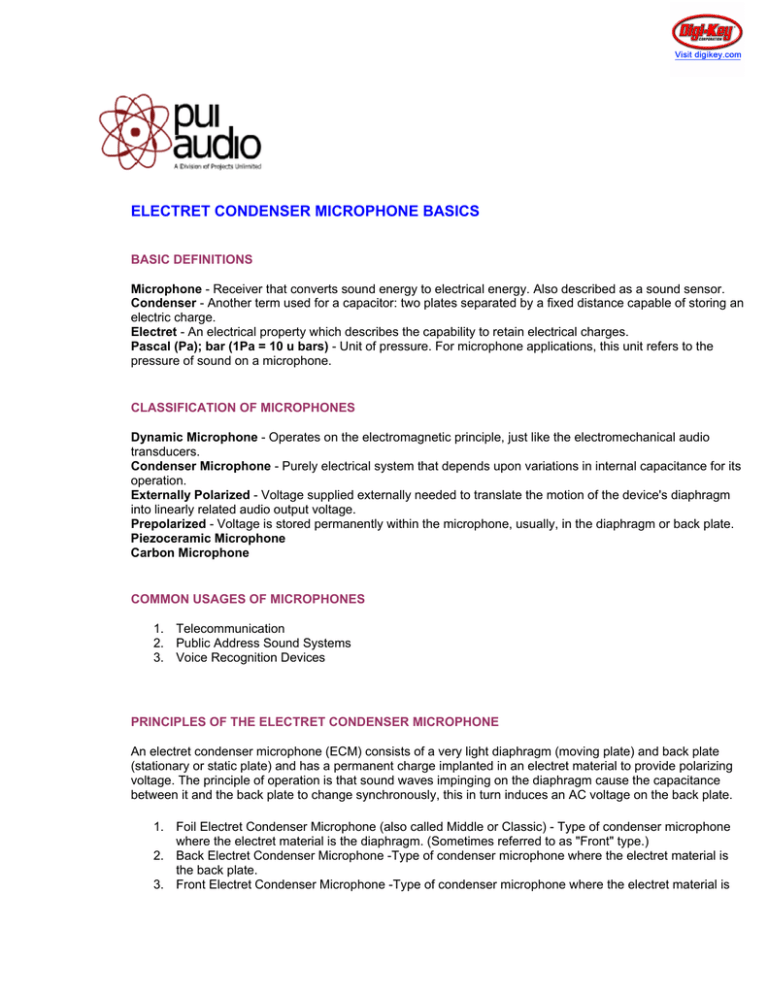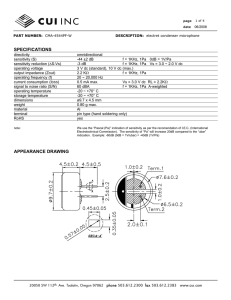
ELECTRET CONDENSER MICROPHONE BASICS
BASIC DEFINITIONS
Microphone - Receiver that converts sound energy to electrical energy. Also described as a sound sensor.
Condenser - Another term used for a capacitor: two plates separated by a fixed distance capable of storing an
electric charge.
Electret - An electrical property which describes the capability to retain electrical charges.
Pascal (Pa); bar (1Pa = 10 u bars) - Unit of pressure. For microphone applications, this unit refers to the
pressure of sound on a microphone.
CLASSIFICATION OF MICROPHONES
Dynamic Microphone - Operates on the electromagnetic principle, just like the electromechanical audio
transducers.
Condenser Microphone - Purely electrical system that depends upon variations in internal capacitance for its
operation.
Externally Polarized - Voltage supplied externally needed to translate the motion of the device's diaphragm
into linearly related audio output voltage.
Prepolarized - Voltage is stored permanently within the microphone, usually, in the diaphragm or back plate.
Piezoceramic Microphone
Carbon Microphone
COMMON USAGES OF MICROPHONES
1. Telecommunication
2. Public Address Sound Systems
3. Voice Recognition Devices
PRINCIPLES OF THE ELECTRET CONDENSER MICROPHONE
An electret condenser microphone (ECM) consists of a very light diaphragm (moving plate) and back plate
(stationary or static plate) and has a permanent charge implanted in an electret material to provide polarizing
voltage. The principle of operation is that sound waves impinging on the diaphragm cause the capacitance
between it and the back plate to change synchronously, this in turn induces an AC voltage on the back plate.
1. Foil Electret Condenser Microphone (also called Middle or Classic) - Type of condenser microphone
where the electret material is the diaphragm. (Sometimes referred to as "Front" type.)
2. Back Electret Condenser Microphone -Type of condenser microphone where the electret material is
the back plate.
3. Front Electret Condenser Microphone -Type of condenser microphone where the electret material is
the inside of the case of the microphone.
COMMON SPECIFICATION TERMINOLOGY
Unit of Measure - There are two different, commonly used units of measure to define the key parameters of
Signal to Noise ratio (S/N Ratio) and Sensitivity. One is "Pascal" and the other is "IJ bar" (micro bar). We use
"Pascal" as the unit of measure in all of our specifications. "Pascal" is currently the most commonly accepted,
however, "p bar" is still used. To convert from "IJ bar" to "Pascal," simply add 20dB. For example:-62dB(0dB=1
V/u bar) = -42dB(0dB= 1 V/pa).(Careful, you are adding a positive number to a negative number)
Sensitivity - Usually expressed in V/Pa (V/10 u bar) at 1 kHz, sensitivity is the output voltage measured when
a sound wave is detected by the microphone in a specified load condition. It is expressed with a specified
resistive load and supply voltage since the output resistance tends towards constant current
characteristics.Sensitivity (dB) = 20 log (V/Pa)
Directivity - Directivity is a characteristic of sensitivity according to the infliction angles of sound waves in the
microphone.
1. Omni directional - The directional property that has identical sensitivities originating from all directions.
2. Bi-directional - The directional property that has identical frontal sensitivity and rear sensitivity values
while side sensitivities are weaker. Also referred to as "cross-talking" and "noise canceling." (Noise
canceling, cross-talking - used in a circumstance of loud noise, eliminates the sound coming from a
long distance and picks up the sound coming from only a short distance. Used in cellular phones and
headset microphones.)
3. Uni directional - The directional property that has the rear sensitivity relatively weaker than the frontal
sensitivity.
Output Impedance - The effective output resistance is determined mainly by the value of load resistance. It
can be made higher or lower by the value of load resistance with a corresponding change in sensitivity. To get
the maximum output, the load should be matched to the output resistance.
Frequency Response Frequency response is the microphone's sensitivity performance in the frequency
range of 0 to 20 kHz. Compared with the dynamic types, ECMs tend to have an extended response both at low
and high frequencies, which is also smoother.In the case of dynamic types, the response limits are defined
where the sensitivity has fallen by 3 dB relative to its value at 1 kHz. It is not stated in such terms for ECMs
since they have a much wider frequency response.
Signal to Noise Ratio - Signal to noise ratio is the ratio of the straight frontal sensitivity of the microphone to
the proper noise voltage. Proper noise is the noise in the microphone which is not produced by the action of
electromagnetic induction, vibration or natural wind. It is the noise produced by the microphone itself. This ratio
gives an idea of how well the signal is detected by the microphone.S (dB) = 20 log (VS/VN)Where: VS = Signal
expressed in voltsVN = Noise expressed in volts
VOLTAGE REDUCTION CHARACTERlSTlCS
This is the reduction in sensitivity with specified load when the supply voltage is reduced from its nominal
value. A lowering of the specified load resistance will also reduce sensitivity.
INSTALLATION
To obtain the best results, avoid placing near reflective surfaces. If possible, mount in soft rubber to insulate
from vibration. Treat ECMs as static sensitive. Use specified heat sinking when soldering to ECMs. Use as
little heat as possible for shortest time consistent with good joint. Avoid subjecting ECMs to high temperature
and humidity that can degrade performance. The frequency response of ECMs may be too extended for
communications application, in which case, it can be limited by suitable acoustic filtering in the intended
housing or handset.
©2008, Projects Unlimited Inc., All Rights Reserved.




